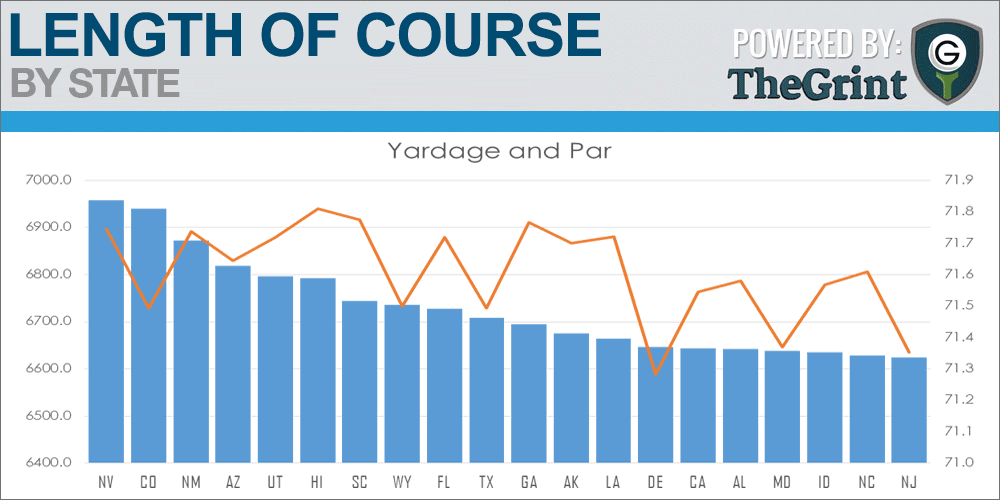Which state has the most golf courses? Which state has the most difficult?
After our last article which looked at Golfer Performance by State, we wanted to dig in a little deeper to see what we could learn about the differences in golf courses between states. Weather, availability (quantity), and difficulty vary dramatically from state to state. We hope this information can help you begin to paint a clearer picture of the greater golf course ecosystem, both locally and within the US as a whole.
About the Data
As with the other articles in this series, we used data for TheGrint, a golf handicap and stat tracking service, which contains information on over 34,000 golf courses world-wide. For this study:
•Only US Courses were used (approximately 60% of the total)
•Par 3 Courses (approximately 20% of US courses) were not factored into the results
•Yardages, Course Ratings and Slope Ratings are based on distance as measured from the longest men’s tee on each course
•The average scores listed includes all scores recorded in TheGrint regardless of the tees used or the sex of the player
The Study

While you’d think this is the sort of information that would be readily available, it’s not something that’s particularly well-publicized. Keep in mind that this data is for 18 hole course only. It does not include Par 3 courses.
Insights:
- Not surprisingly Florida occupies the top position boasting over 1000 golf courses within its borders.
- Would you have imagined that Michigan would have more courses than California and Texas.
- Also of note, of the more than 13,000 courses in the USA, 75% of them are located within these top 20 states.
One of the most interesting bits of data is the difference in course difficulty between states. To determine difficulty we start with the USGA’s Course and Slope Rating system. We must assume that there is no bias in the USGA’s system, and that golf courses are rated using standard and equivalent practices.
To calculate which states have the most difficult golf courses,the team at TheGrint used a combination of course rating, slope, and the par of the course as measured from the longest tees.
The formula for TheGrint’s difficult rating is: (Course Rating – Par) + (Slope/113)
Insights:
- Hawaii has the most difficult courses, followed by Nevada and Florida
- As you may recall from our previous study, Ohio has the best golfers, but since its absence from the Top 20 for difficulty suggests its courses could be of below average difficulty.
The length of a golf course is an important factor in scoring. Course length is also contributes to the par of golf course.
Insights:
- Nevada and Colorado have the longest courses, averaging more than 6,900 yards each.
- All of these golf courses provide different tee options, so regardless of potential length, golfers are generally able to play courses at similar distances.
- Hawaii, South Carolina, and Georgia were the states with the highest par average (71.8), which suggests the majority of courses within those states are par 72.
Finally, we wanted to use some of the data collected from TheGrint to compare user reviews/ratings to the average scores on a per state basis.
We thought it would be interesting to see if the data would suggest that one was tied to the other.
Insights:
- Courses in Montana were rated highest, with more than a 2 point difference between it and Vermont (second) and South Dakota (third).
- The data suggests little if any correlation between score and course review.
- Are courses in the top states better, or are users of TheGrint in those states more easy-going and generally happier?
Stay Tuned
This information should provide a solid introduction to our next set of articles where we will show you the Top 20 ranking of individual golf courses by state based, on the more than 750,000 course reviews in TheGrint’s database.


















Michael Lee
5 years ago
I think that it would be a fun trip to go to a golf course in every state. I would not have thought that the United States accounted for 60% of golf courses worldwide. It is also interesting that the average difficulty differs by so much by state.